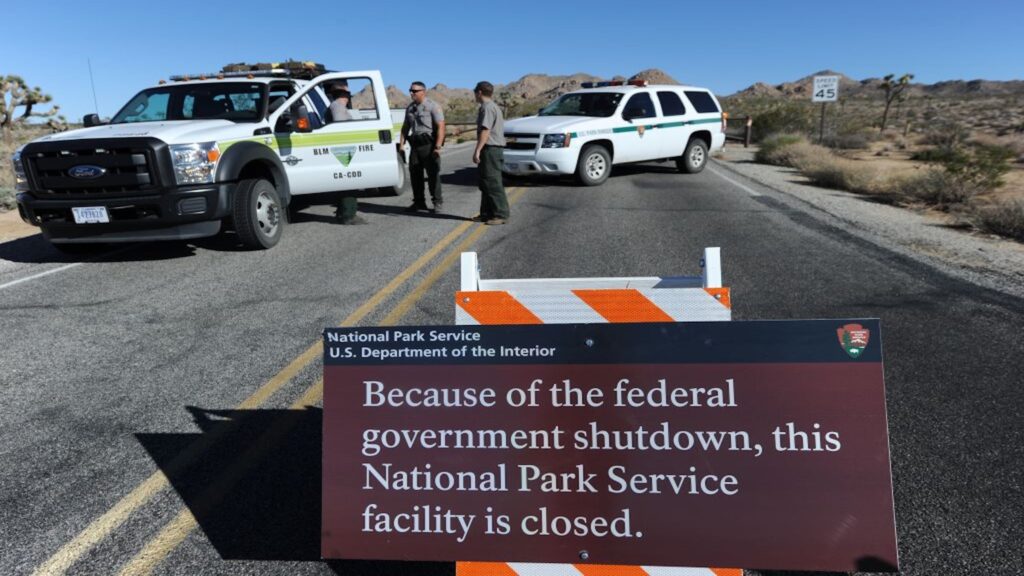At least 80 percent of funding from National Park Service recreation fees stays in the park where it is collected, and the other 20 percent is used to benefit parks that do not collect payments or parks that generate only a small amount of revenue
Park Rangers stand at the closed gate to Joshua Tree National Park, in Joshua Tree, California, during the 2013 government shutdown (Photo: ROBYN BECK/AFP via Getty Images)
Published October 17, 2025 04:05PM
Despite expert recommendations to close national parks during the government shutdown, people are still flocking to—and in some cases disrupting—some of the country’s most popular publicly owned lands. These visits aren’t just taxing on the land; they’re also causing a massive loss of revenue across the national park system.
Every day that the government is shut down, Parks face losing an estimated $1 million in fee revenue, according to a report published by the nonprofit organization, the National Park Conservation Association (NPCA).
On September 30, Congress failed to pass a federal budget, prompting a government shutdown. The National Park Service (NPS) is housed within the Department of the Interior, meaning that Congress is responsible for approving the agency’s annual budget. During federal closures, government programs and sites considered non-essential to national security or safety—such as those run by the NPS—are at risk of losing both funding and employees.
Impacts of the 2025 federal government shutdown have been felt across the 433-site national park system. Some local communities, for instance, have stepped in to offset budget cuts to keep the nation’s most visited park open. Food pantries in Arizona have opened their cupboards to help feed park staff who have been furloughed or are otherwise not receiving a paycheck.
Still, Park Service data crunched by the NPCA shows that national parks could lose more than $1 million in fee revenue every day they’re closed.
“Based on the Park Service’s shutdown plan, almost 9,300 people (nearly two-thirds of Park Service staff) are now being put in the scary position of not knowing when their next paycheck will arrive,” wrote NPCA in a statement. “Additionally, park concessioners and partners now face the prospect of lost revenue and further economic hardship—local economies could lose as much as $80 million in visitor spending every day parks are closed in October.”
Under the park’s contingency plan, entrance gates and accessible areas are allowed to remain open, though doors at most facilities and visitor centers are closed. More than 100 NPS sites charge entrance fees ranging between $10 and $20 per person.
Pressure is being felt at Utah’s Zion National Park, which charges an entrance fee of $35 per vehicle. The Salt Lake Tribune reports that the park is still losing money despite donations from some visitors.
“Thousands of people have continued to visit Zion each day during the shutdown. One day last weekend, roughly 25,000 people toured the park,” reported the publication, adding that the park “is losing $35,000 to $50,000 per day in entrance fees.”
Entrance fees cover critical services at national parks, like shuttle services and infrastructure improvements. But with no one to staff the gates, fees are going uncollected.
According to NPS, the current Federal Lands Recreation Enhancement Act allows the agency to collect and retain revenue. It requires that fee revenue be used to enhance visitor experience.
“At least 80 percent of funding from recreation fees stays in the park where it is collected, and the other 20 percent is used to benefit parks that do not collect fees or parks which generate only a small amount of revenue,” writes NPS on its website.
When the government will reopen is unclear. The most recent—and longest—government shutdown lasted 35 days, from December 2018 to January 2019.


